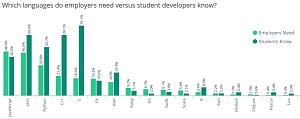News
Report: Despite High JavaScript Demand, Student Devs Learning Ruby and Python
- By David Ramel
- December 11, 2018
Despite a gap between the supply of available JavaScript talent and enterprise demand for such skills, student developers are more interested in learning Ruby and Python.
However, younger coders do have JavaScript at No. 3 on their "to-learn" lists, so the supply-and-demand conundrum in the enterprise dev space may be waning, indicates a new Student Developer Report 2018 from HackerRank.
That would be good news for businesses who, according to other research, have some 580,000 open computing jobs in the U.S. alone, while fewer than 50,000 computer science graduates are entering the workforce.
HackerRank provides a technical hiring platform to help organizations evaluate software developers based on skill rather than more traditional criteria like computer science degrees and grade point averages. It recently surveyed more than 10,000 student developers to glean data that hiring managers might use to improve the identification, recruitment and retention of the next generation of skilled developers.
In addition to the mismatch between programming language skills wanted by organizations and languages that student developers want to learn, the survey found other differences between university coders and their older, professional brethren.
 [Click on image for larger view.]
Wanted & Known Skills (source: HackerRank)
[Click on image for larger view.]
Wanted & Known Skills (source: HackerRank)
For example, student developers, who rely heavily on teaching themselves, are more likely to turn to video teaching resources like YouTube to further their knowledge. Pros, meanwhile, are more likely to rely on Stack Overflow, books, courses, online tutorials and other more traditional means of education.
 [Click on image for larger view.]
Skills Wanted to Learn (source: HackerRank)
[Click on image for larger view.]
Skills Wanted to Learn (source: HackerRank)
"This new class of developers is drawn to platforms that allow for self-paced learning and flexibility," HackerRank said.
Other data points of interest called out by the firm from the survey results include:
- Globally, student JavaScript expertise can't keep up with demand. With 95 percent of Web applications built on JavaScript, it's no surprise that the programming language has become one of the most in-demand skills for companies. HackerRank found that while 48 percent of employers are looking for JavaScript proficiency, only 42 percent of students worldwide say they know the language. Examining the data regionally, HackerRank found the largest gaps in India and Canada.
- Growth opportunities appeal 5x more than perks. The three most important criteria students look for in job opportunities are: professional growth and learning (58 percent), work/life balance (52 percent) and having interesting problems to solve (46 percent). Student developers have a stronger appetite for growth opportunities than compensation (18 percent) and perks (11 percent), which they view as niceties as opposed to deal-breakers. Companies looking to attract new graduates must ensure they are considering these career preferences as they design and market software developer jobs.
- Frameworks are generally learned on the job. Students are underprepared to leverage the frameworks employers need, with the biggest knowledge gaps residing in AngularJS, React, Node.js, and Spring. No individual country's students could meet even half of employers' framework demands. This discrepancy traces back to fundamentals-focused CS curriculums; in most CS programs, students learn to build knowledge of theories and fundamentals, not job skills. The reason is multi-faceted: university curriculums have neither the industry feedback, nor the agility, nor the resources to stay in sync with industry trends.
- College degrees are not sufficient for coding proficiency. Today's students are not relying solely on university CS curricula to give them the necessary skills they need for software development. Over half of student developers (65 percent) report they are partially reliant on self-teaching to learn to code, with nearly a third (27 percent) claiming they are completely self-taught. This notable rise in self-directed learning shows that students are taking initiative to supplement their coursework.
HackerRank gathered the data in a SurveyMonkey-hosted online survey that was up from Oct. 16-Nov 1, 2017, polling 10,351 student developers who were recruited via e-mail from HackerRank community developers and through social media sites.
About the Author
David Ramel is an editor and writer at Converge 360.